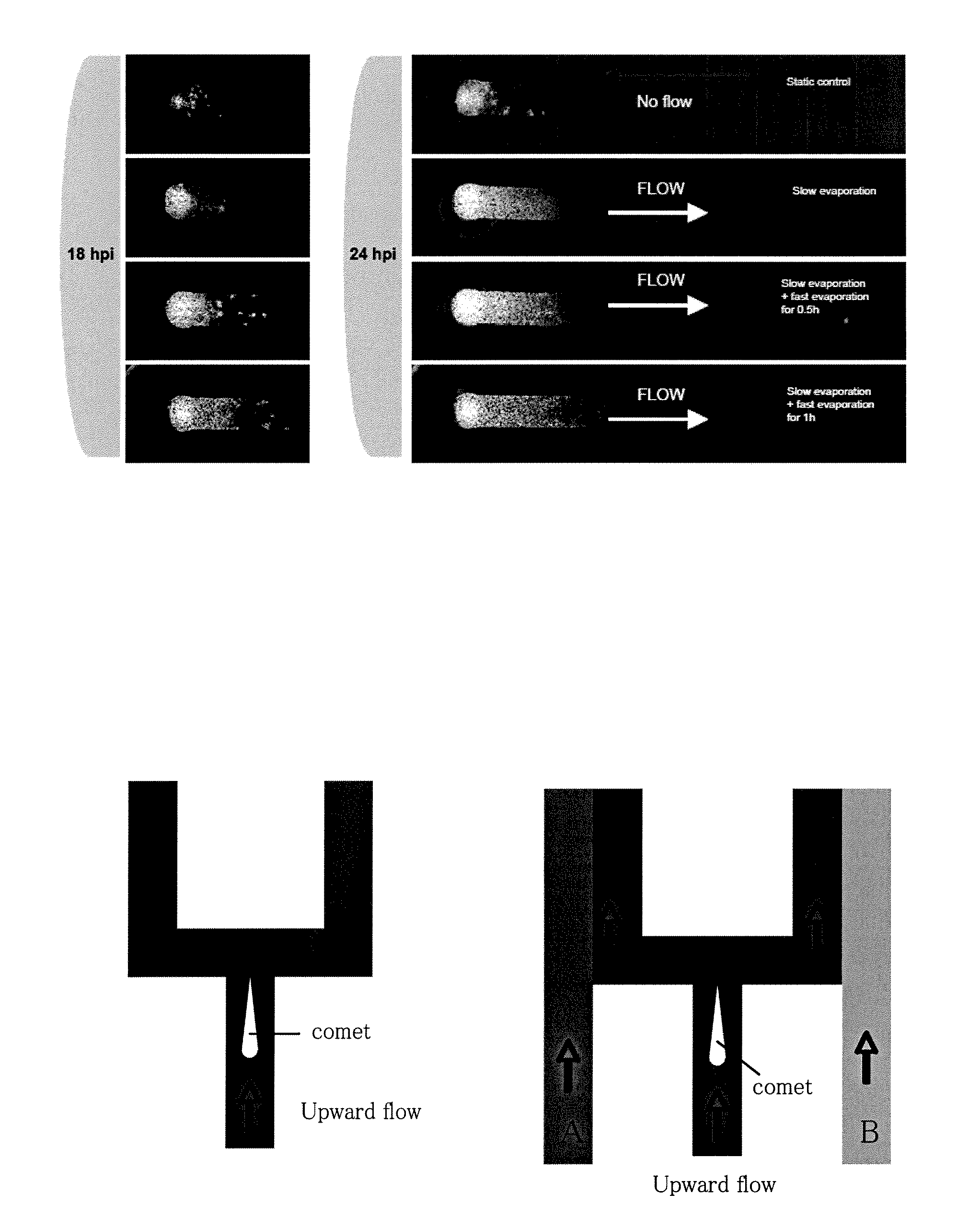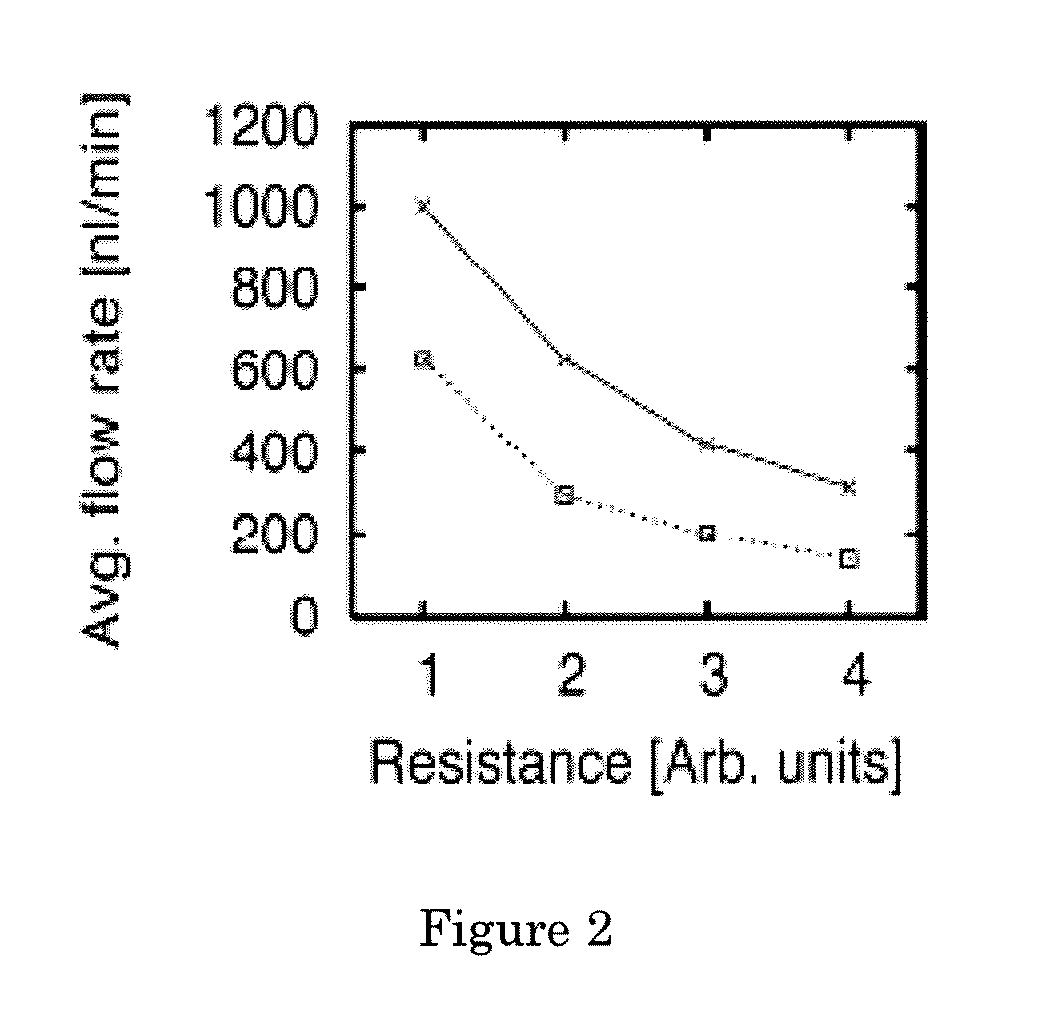Methods and Devices for Quantitative Viral Assays
a quantitative and viral assay technology, applied in the field of methods and microfluidic devices, can solve the problems of difficult repeatability, inability to precisely control the flow environment, and inability to accurately and accurately measure the viral replication ability, and achieve the effect of extending the spread and better reflecting the replication ability of the virus
- Summary
- Abstract
- Description
- Claims
- Application Information
AI Technical Summary
Benefits of technology
Problems solved by technology
Method used
Image
Examples
example 1
Comet Assay Measures Drug Susceptibility with High Sensitivity
1. Methods
[0066] Cell culture. Baby hamster kidney (BHK-21) cells were originally obtained from Dr. I. Novella (Medical College of Ohio) and grown as monolayers at 37° C. in a humidified atmosphere containing 5% CO2. Growth medium consisted of Minimum Essential Medium Eagle with Earle's Salts (MEM, Cellgro), 10% fetal bovine serum (FBS, Hyclone), and 2 mM Glutamax I (Glu, Gibco). Cells were subcultured approximately every fourth day. For subculture, monolayers were rinsed with Hank's Balanced Salt Solution (HBSS, Hyclone), incubated in 0.05% trypsin / 0.53 mM EDTA (Gibco) for 5 minutes, and replated in fresh growth medium at a 1:30 dilution. No antibiotics were used and cells were subcultured no more than 100 passages to minimize the artifacts due to cell senescence. Viability of cell populations, as determined by trypan blue exclusion, at the time of experiments always approached 100%. In all the antiviral assays used i...
example 2
Cells Grow in Microchannels
[0075] Microchannels were made from poly(dimethylsiloxane) (PDMS), with a configuration of two ports joined by a channel, as shown in FIG. 1. Typical total volume of the channel and two ports is 8 microliters. The ‘floor’ of the microchannel is typically the bottom of a culture well in a standard six-well polystyrene culture plate. Cells added to the channel through one port adhere to the ‘floor’ and eventually flatten out and form a monolayer.
[0076] Baby hamster kidney (BHK21) cells were seeded into microchannels at 1000 cells / mm2, in the presence of growth medium. Phase contrast images were obtained at indicated times (hours post cell loading=HPCL=number of hours after cells were loaded into the microchannel). Representative images are shown in FIG. 7.
[0077] Quantification of cell growth in microchannels. A BHK cell suspension was injected into a channel through one port. Such cell loading was performed with several channels in parallel. At indicated ...
example 3
Flow-Enhanced Spread of Virus Infections in Microchannels
[0081] BHK cells were loaded into the microchannels at 4·106 cells / ml to create confluent monolayers. Control and test channels were all inoculated with one microliter of virus inoculum containing fewer than 10 plaque forming units; this one microliter volume is sufficient to displace the initial volume of fluid in the port. Both ports of the control “no-flow” sample were covered with pieces of PDMS to minimize evaporation from the channel and thereby maintain a static fluid environment. The test samples were inoculated in the same manner, but flows were induced by creating imbalances in the evaporation rates from the two ports, as follows. A 5-microliter droplet of 2% medium was added on one port. Therefore, when evaporation occurred, medium flowed from the droplet through the channel to the other port. To achieve slow-flow conditions samples were placed in a ‘high-humidity’ (or slow evaporation) incubator, containing a pan ...
PUM
| Property | Measurement | Unit |
|---|---|---|
| flow velocity | aaaaa | aaaaa |
| volume | aaaaa | aaaaa |
| volume | aaaaa | aaaaa |
Abstract
Description
Claims
Application Information
 Login to View More
Login to View More - R&D
- Intellectual Property
- Life Sciences
- Materials
- Tech Scout
- Unparalleled Data Quality
- Higher Quality Content
- 60% Fewer Hallucinations
Browse by: Latest US Patents, China's latest patents, Technical Efficacy Thesaurus, Application Domain, Technology Topic, Popular Technical Reports.
© 2025 PatSnap. All rights reserved.Legal|Privacy policy|Modern Slavery Act Transparency Statement|Sitemap|About US| Contact US: help@patsnap.com



